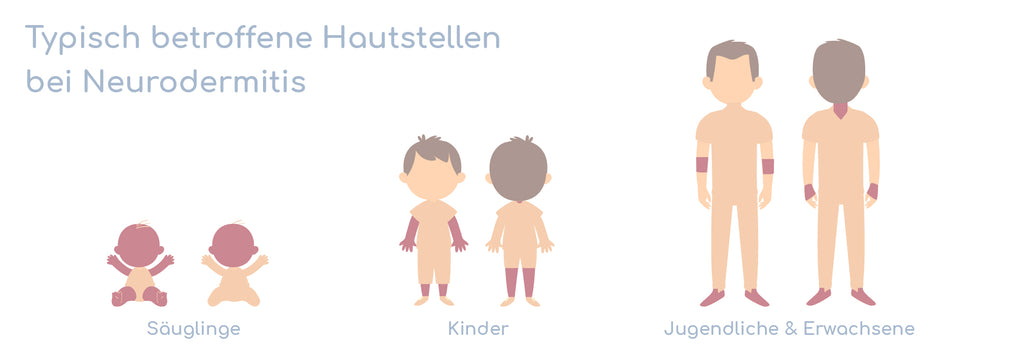
Neurodermatitis, also known as atopic dermatitis or atopic eczema, is a chronic inflammatory skin disease that typically occurs in flare-ups. Between flare-ups, the skin may look largely normal. During a flare-up, however, the characteristic symptoms often occur: redness, itching and dry flaking.
A diagnosis can only be made by a specialist. Here you can read about the typical symptoms and signs of neurodermatitis.
What are typical symptoms and signs of neurodermatitis?
- Severe itching
- Dry, possibly flaky skin
- Eczema: varies by age
- possibly so-called shiny nails, inflammation of the lips/corners of the mouth
- Occurrence of associated atopic stigmata (skin signs, e.g. double lower eyelid fold, or the occurrence of other atopic diseases, such as hay fever and asthma)
Where on the body do neurodermatitis symptoms occur?
The symptoms can occur in different parts of the body and vary depending on age and individual course:

Infants and babies : Infants and babies often have flat, firmly adhering, yellowish scales or reddish, sometimes weeping patches of skin on the face, scalp (then known as cradle cap ) and on the extensor sides of the arms and legs
Children : in older children, the dry, scaly eczema appears mainly on the extremities, the bends of the joints and the neck; in severe cases, the skin thickens with coarser skin patches (so-called lichenification)
Adolescents and adults : in adolescents and adults, neurodermatitis often occurs on the crooks of the arms, backs of the knees, wrists, neck, face and décolleté
Can I recognize and diagnose neurodermatitis myself?
The symptoms and signs described are characteristic of neurodermatitis. However, other skin diseases can also have similar symptoms, which is why the diagnosis must ultimately be made by a doctor.
For this reason, we recommend that you consult a dermatologist or pediatrician if you suspect neurodermatitis. Only a specialist can make a precise diagnosis and recommend the appropriate treatment.
But first the good news: around 60% of affected children are symptom-free as young adults. Chronic courses are more common when several family members suffer from neurodermatitis, hay fever or asthma, when the person also suffers from these diseases or when the course was already severe in childhood.
You can also click through our skin advice guide for babies - perhaps you will find helpful answers here!







